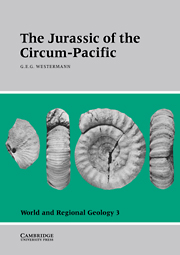Book contents
- Frontmatter
- Contents
- List of contributors
- Preface
- Acknowledgments
- Introduction
- Part I Time scales
- Part II Circum-Pacific base map
- Part III Regional geology and stratigraphy
- Part IV Biochronology
- Part V Biogeography
- 18 Macroflora of eastern Asia and other circum-Pacific areas
- 19 Ostracods and foraminifers of Western Interior North America
- 20 Ostracods of China
- 21 Corals of the circum-Pacific region
- 22 Brachiopods of the circum-Pacific region
- 23 Belemnites of the circum-Pacific region
- 24 Ammonites of the circum-Pacific region
- 25 Fishes of the circum-Pacific region
- 26 Marine reptiles of the circum-Pacific region
- Part VI Climatology and oceanography
- Appendix: Biochronology and atlas with index and guide fossils
- General Index
- Index of Guide- and Indexfossils
19 - Ostracods and foraminifers of Western Interior North America
Published online by Cambridge University Press: 04 August 2010
- Frontmatter
- Contents
- List of contributors
- Preface
- Acknowledgments
- Introduction
- Part I Time scales
- Part II Circum-Pacific base map
- Part III Regional geology and stratigraphy
- Part IV Biochronology
- Part V Biogeography
- 18 Macroflora of eastern Asia and other circum-Pacific areas
- 19 Ostracods and foraminifers of Western Interior North America
- 20 Ostracods of China
- 21 Corals of the circum-Pacific region
- 22 Brachiopods of the circum-Pacific region
- 23 Belemnites of the circum-Pacific region
- 24 Ammonites of the circum-Pacific region
- 25 Fishes of the circum-Pacific region
- 26 Marine reptiles of the circum-Pacific region
- Part VI Climatology and oceanography
- Appendix: Biochronology and atlas with index and guide fossils
- General Index
- Index of Guide- and Indexfossils
Summary
The paleoenvironmental assessment of this area is based on the well-documented Jurassic microfaunas of the subsurface of southern Saskatchewan (Wall 1960; Brooke and Braun 1972) and on the exposures in the northeastern Canadian Rocky Mountains (Brooke and Braun 1981). Of more general interest are shorter accounts about Jurassic ostracods or foraminifers or both groups from surface exposures in the Black Hills (South Dakota and northeastern Wyoming), southern Montana, the Little Rocky Mountains (northcentral Montana), and the southern Canadian Rocky Mountains and their foothills of southeastern British Columbia, as documented in the References section. The microfossils reached their greatest diversity and abundance in the intercratonic sequences of the Williston Basin, which straddles the Canada–United States border in the heartland of the North American continent (Figure 19.1). They are less varied, less abundant, erratically distributed, and generally poorly preserved in the deformed sedimentary pile of the Rocky Mountain miogeocline and its Western Canada Basin. Nothing has been published as yet about varied foraminiferal, radiolarian, and ostracod faunas that are known to exist in the sedimentary-volcanic Jurassic sequences of the Queen Charlotte Islands off the coast of British Columbia, representing the eugeoclinal realm.
On a generic level, most Middle Jurassic Foraminifera and Ostracoda of the Western Interior regions compare closely with western European, Russian, and other Jurassic microfaunas, but many of their species are endemic, especially among the ostracods. This imparts a distinctive character to the microfauna, setting it apart from other contemporaneous assemblages and reminding of the provinciality in ammonites and megafaunas.
- Type
- Chapter
- Information
- The Jurassic of the Circum-Pacific , pp. 317 - 321Publisher: Cambridge University PressPrint publication year: 1993



